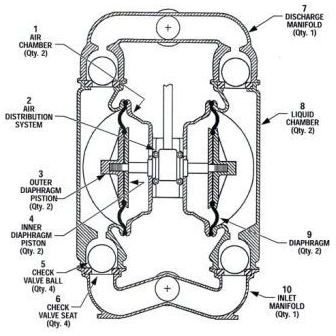What is Reciprocating Hydraulic Diaphragm Pump? Types of Diaphragm Pumps? What is Diaphragm Pump?
Diaphragm Pump - Construction
Diaphragm pumps have a reciprocating diaphragm in a liquid chamber in place of reciprocating piston inside a cylinder to produce the pumping action of the reciprocating positive displacement pump. The arrangement of valves and their functioning is same as that in the piston or plunger pumps. The liquid chamber is formed of the fixed body of the pump and the diaphragm is fitted to one side of the chamber. The diaphragm is coupled to an actuating part which moves the diaphragm.
Diaphragm Pump - Working
By the action of the actuators the diaphragm bulges in and out of the liquid chamber. When the diaphragm bulges out of the liquid chamber the volume of the chamber increases and pressure inside the chamber decreases, this opens the inlet valve and liquid is taken inside the chamber. When the diaphragm bulges in the chamber the volume of the chamber decreases and the pressure increases which opens the outlet valve and the liquid is pumped out of the chamber. The diaphragm does not have any frictional motion with the chamber, thus, there is no need of any seal or liner.
The movement of the diaphragm can be obtained either by hydraulic plunger or by air pressure. Based on the type of actuation of the diaphragm the diaphragm pumps are of two types, Hydraulically operated or Air Operated Diaphragm Pumps.
Hydraulically Operated Diaphragm Pump
The diaphragm is reciprocated by the action of hydraulic fluid and the fluid itself is pumped by a reciprocating piston. Thus, one piston pump is making the other diaphragm pump work. The diaphragm has driving hydraulic fluid one side and the liquid to be pumped on the other side. The piston pumps the driving fluid which moves the diaphragm and in turn pumps the liquid on the other side. This arrangement avoids any contact between the pumping element and the liquid pumped. This avoids leakage and makes the pump suitable for handling expensive, explosive or toxic liquids.
Air Operated Diaphragm Pumps
The Air Operated Diaphragm Pumps have two chambers, each divided into two parts by flexible diaphragms. The liquid side of both the chambers has inlet and outlet non return type valves. The centers of the two diaphragms are interconnected with a rigid rod. There is a supply of pressurized air which is controlled by a valve system. At one time it allows air to enter one of the air chamber and exhaust from the other chamber.

The chamber receiving the air pushes the fluid out thorough outlet valve and the other chamber takes in the fluid through inlet valve. After reaching the end of the stroke the air control valve reverses the direction of air flow in the air chambers, thus reversing the flow of the liquid in the liquid chambers. This configuration creates a double acting pump.
The construction of Diaphragm Pumps is such that there is no direct contact between the power source and the liquid to be pumped. Moreover, there is no frictional motion between the pumping chamber elements. Thus diaphragm pump does not require seals, there is least possibility of leakage and contamination of the liquid and also there will be no heat generated due to friction. All these properties of the diaphragm pumps make them suitable and reliable for pumping corrosive, abrasive, viscous, toxic and inflammable liquids safely.
This post is part of the series: Fluid Pumps
Fluid Pump or Hydraulic Pump is a machine which transfers the energy from its moving parts to the fluid passing through the machine. The energy transferred from the Pump to the fluid appears as the pressure and velocity of the fluid. Know more about Fluid or Hydraulic Pumps in this article series.
